Story of Meissen(Meißen) Porcelain, the White Gold of Dresden
Augustus II the Strong, the Elector Prince of Saxony and the King of Poland was an avid patron of arts and decided that Dresden would be the cultural center. He also had a great liking for gold, real yellow ones. His great love, bordering on avarice, resulted in him recruiting a young alchemist work on the Goldmacher Tinktur or the Gold making formula to convert base metals to gold.
This post has been updated with latest content in July, 2023
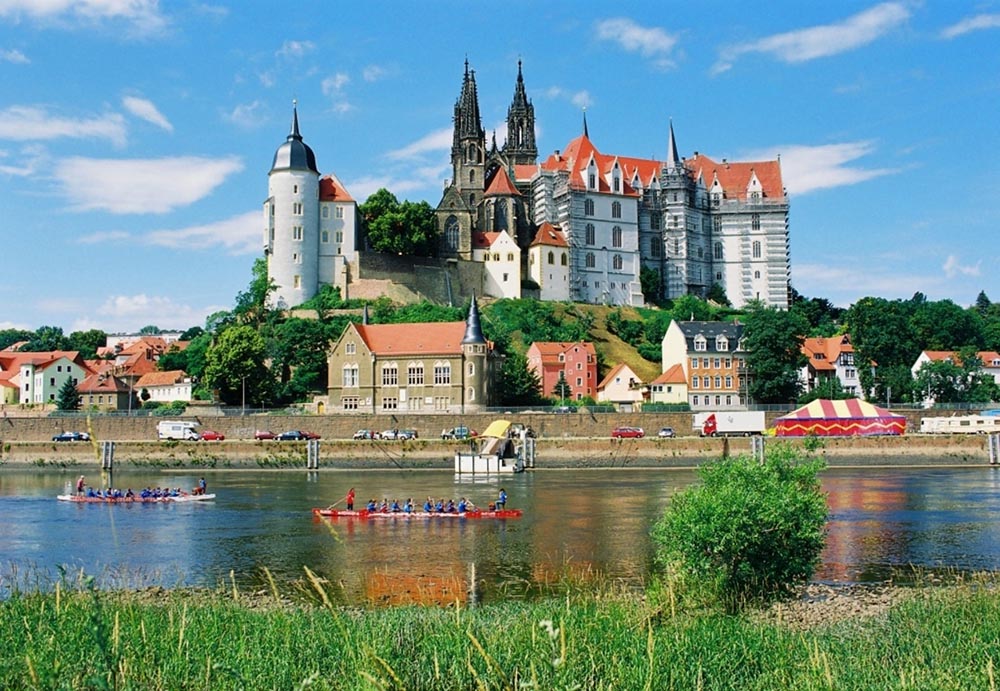
You may say, oh not another of those stories but hold your horses. .
The alchemist, Johann Friedrich Böttger, worked on project gold for nearly six years. However, he did not succeed in producing the gold but he and his mentor, Ehrenfried Walther von Tschirnhaus, were successful in creating the white gold. While there may be a raging debate as to who brought white gold to Europe first, there is no debate as to how much it was valued during those days.
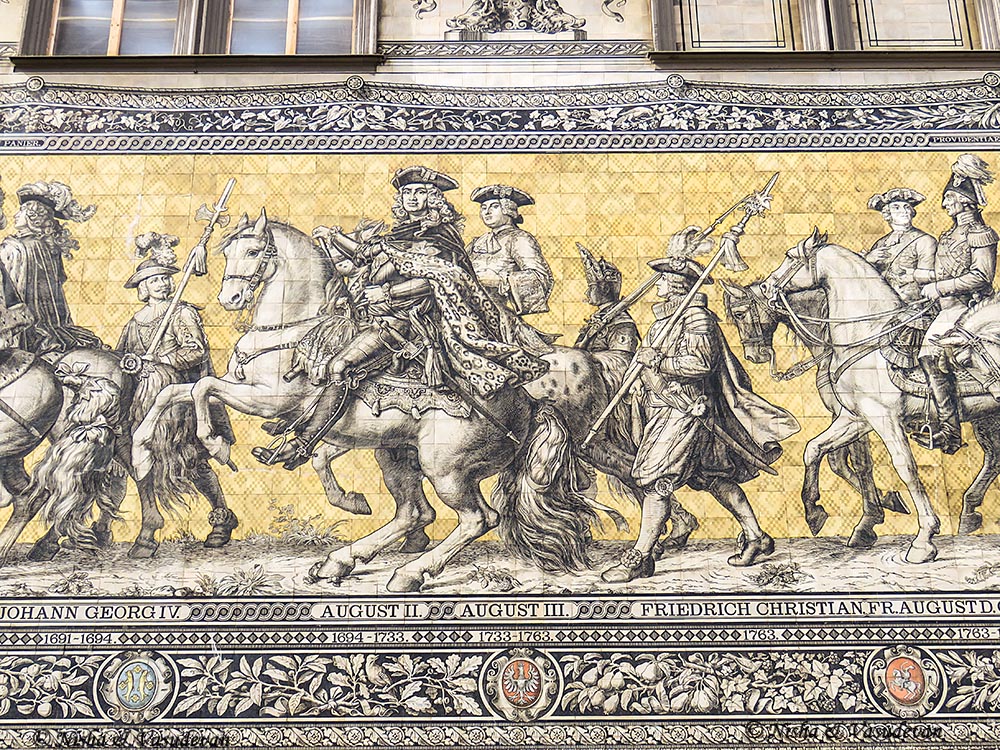
Yes, I am talking about porcelain. Porcelain was worth its weight almost as much as gold in those days and could be manufactured. When the Augustus saw this, he also saw profit in this process. He was excited and set up a factory in Meissen, Germany in 1710 and Meissen Porcelain Manufactory was born and is in business even today!
The location of the first factory was right inside the Albrechtsburg Castle itself and was its home for 150 years before the factory was moved out. Augustus chose Meissen because the small town had extensive local deposits of Kaolin, a clay ingredient needed for fine porcelain creation. The castle was quiet and isolated; a good place for work and creativity.
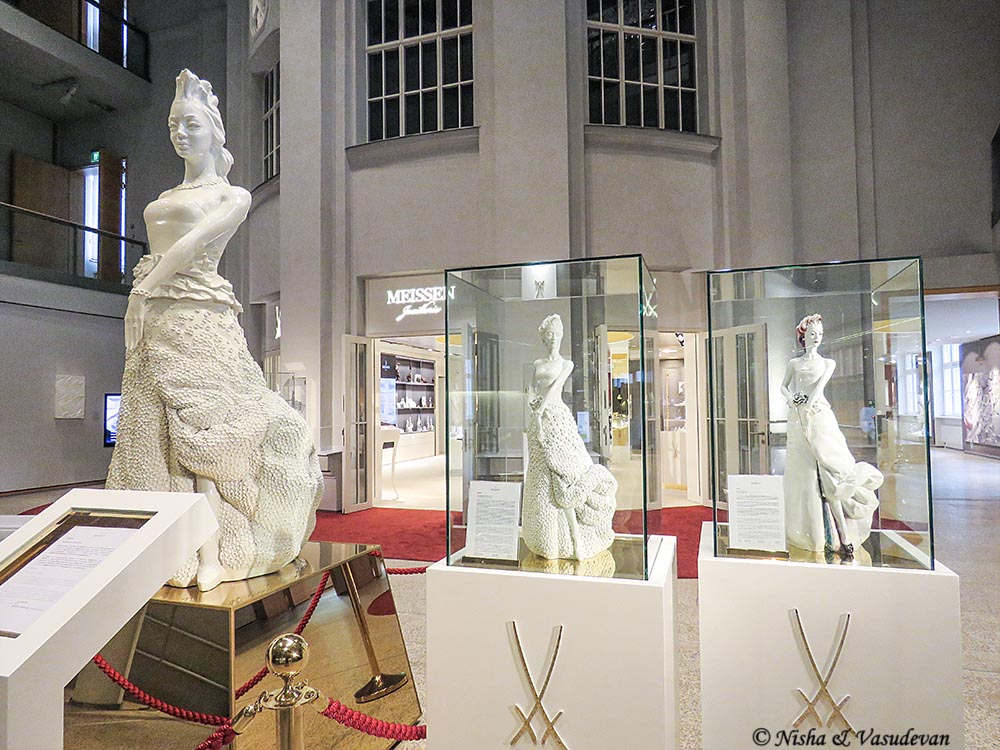
Related Read
If you are wondering what else you can do in Dresden, read here.
If you are traveling in winter, Dresden is a great European destination in winter as well.
Also read about Golden Grass Handicraft in Jajpur, Odisha
After hearing the story we were now ready for the Meissen Porcelain Museum and the workshop too. Right at the entrance, greeting us was Saxonia, Saxony’s Icon specially created for the 25th anniversary of German reunification. Saxonia, who is often called the Statue of Liberty of Saxony, is perhaps the tallest free standing handmade Meissen porcelain sculpture decorated with 8000 handmade flowers on her dress. It weighs 800 kilograms, or over 1700 pounds.
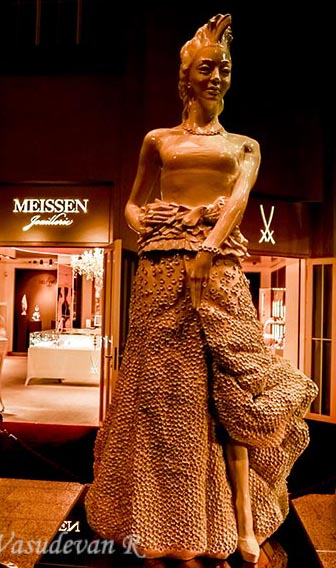
Abracadabra, the enchantment rooms
To see the magic we entered the first of the studios, where fresh white clay was being transformed, first into small balls of white then into various small parts that go into making a bigger object. Every part was handmade by creating the shapes required by hand or by using a mould or by a small potter’s wheel! The clay is mixed with other secret ingredients, as per a well-protected recipe and comes to this place ready to use.
Porcelain Moulding
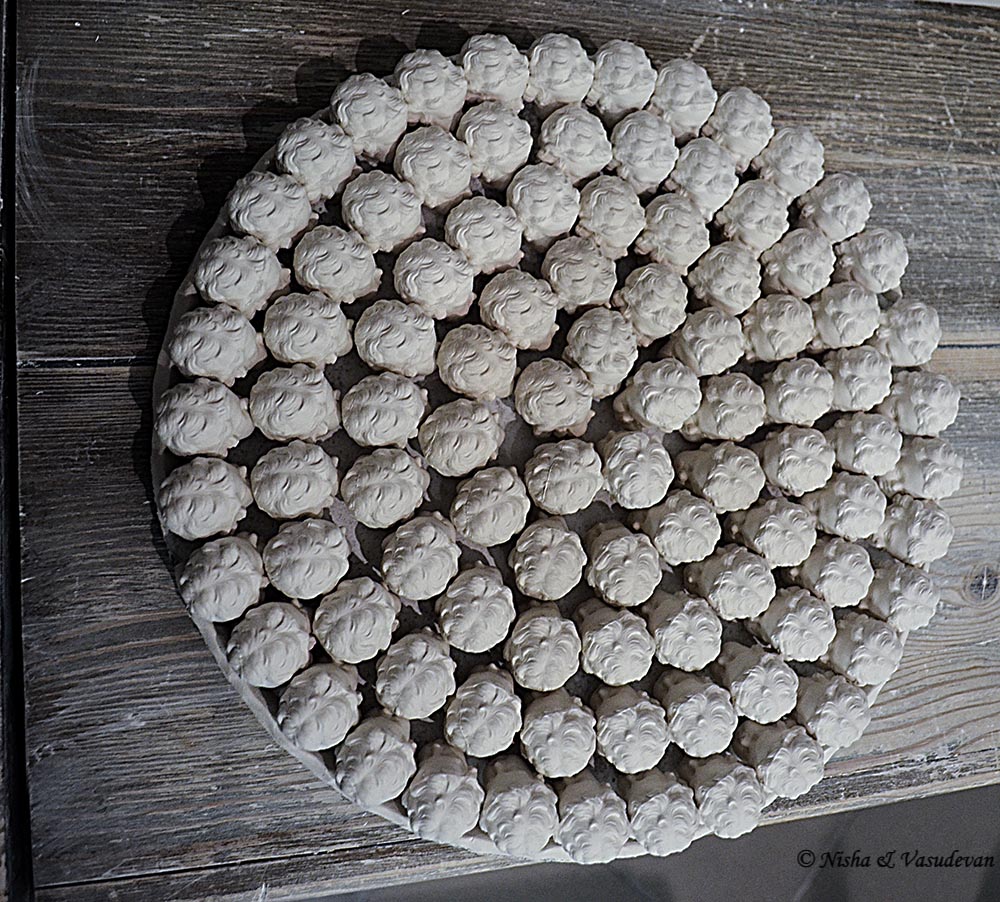
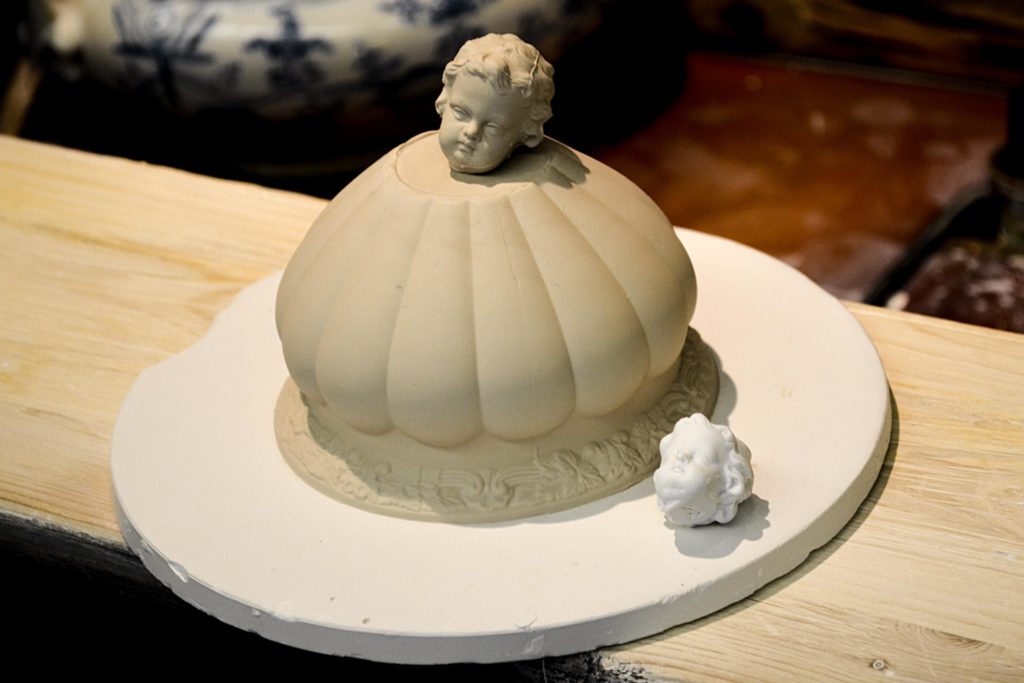

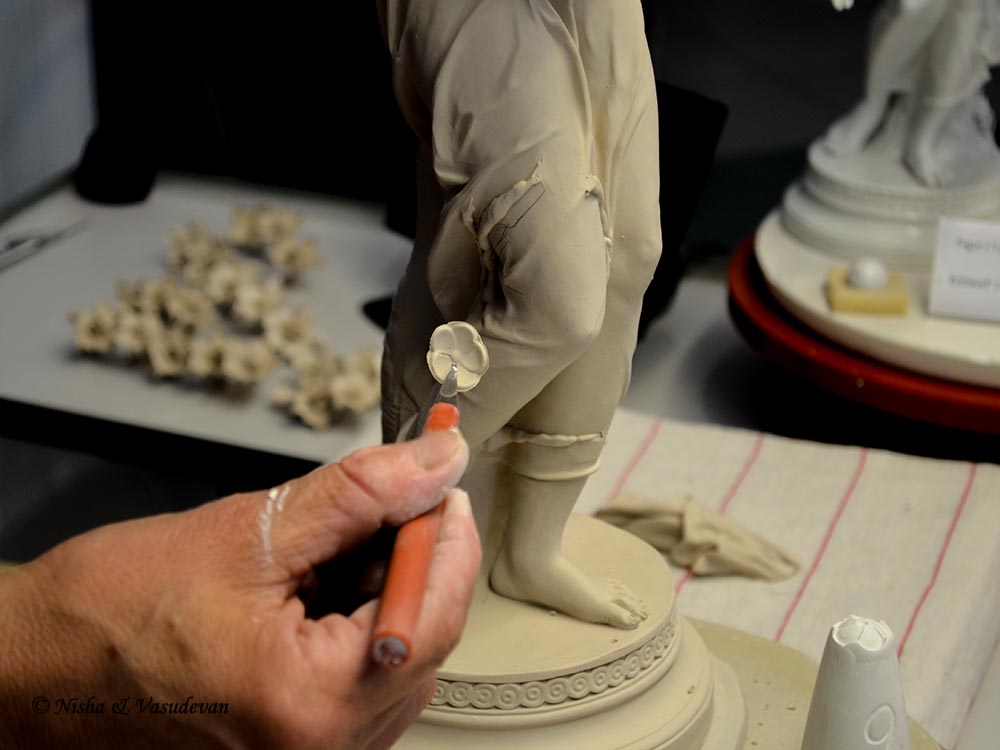
Porcelain Finishing
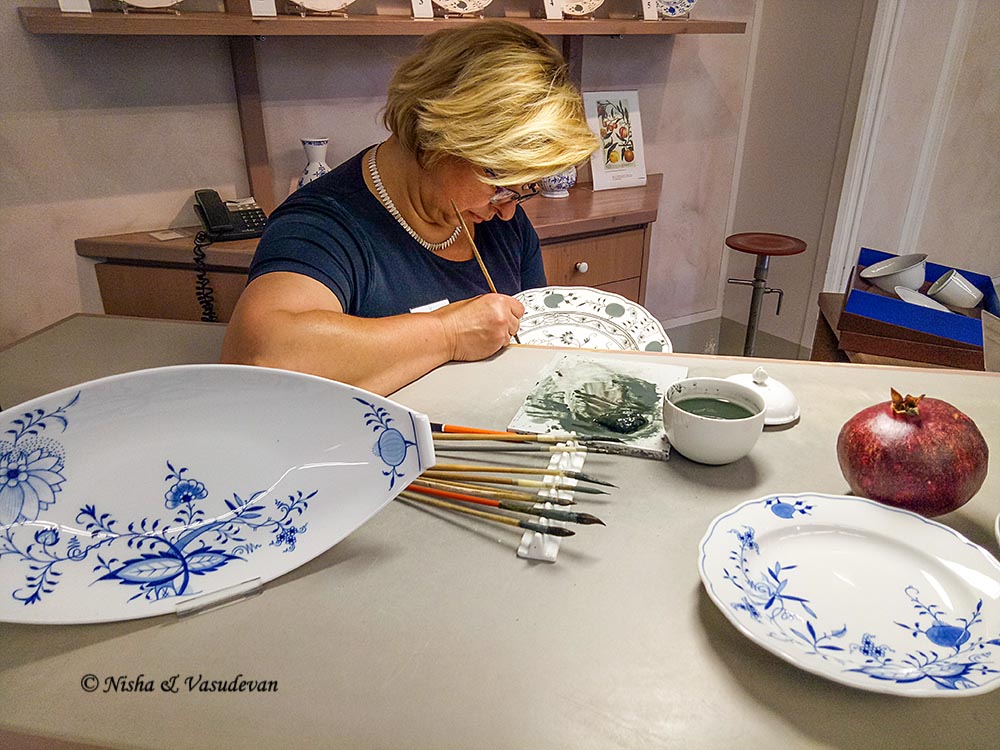
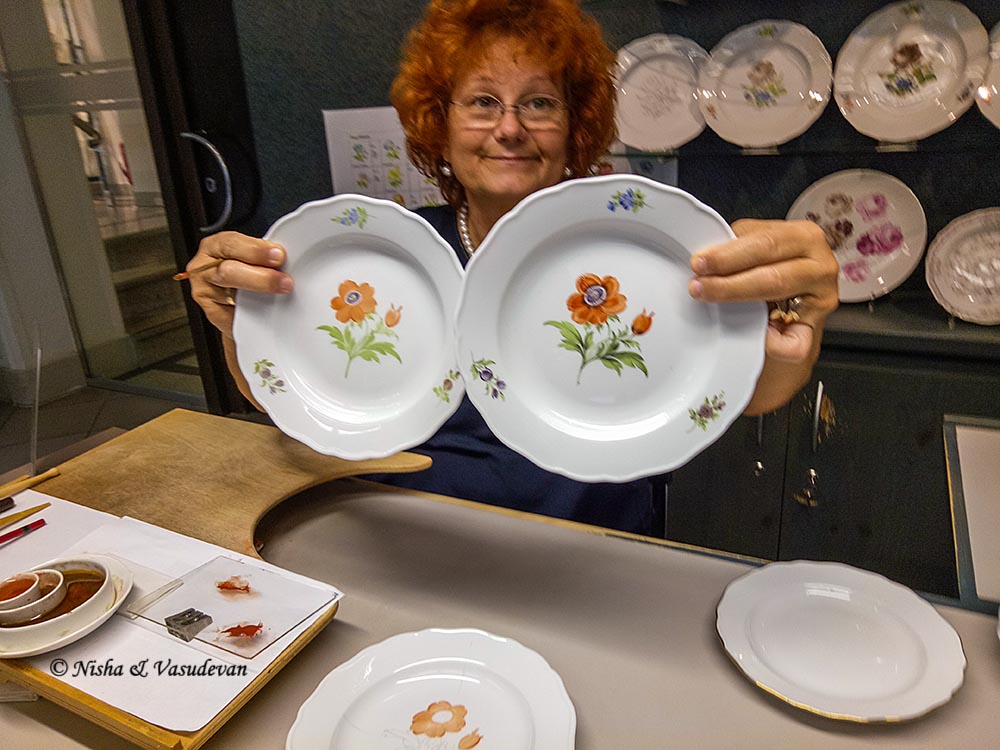

The first Meissen porcelain products produced successfully were gold decorations. Later, in 1723 multicolor enameled painting was introduced. Initially the Meissen artists created enamel porcelain paintings of oriental patterns. Then they expanded to detailed landscapes, animals, flowers and Chinese-inspired decoration.
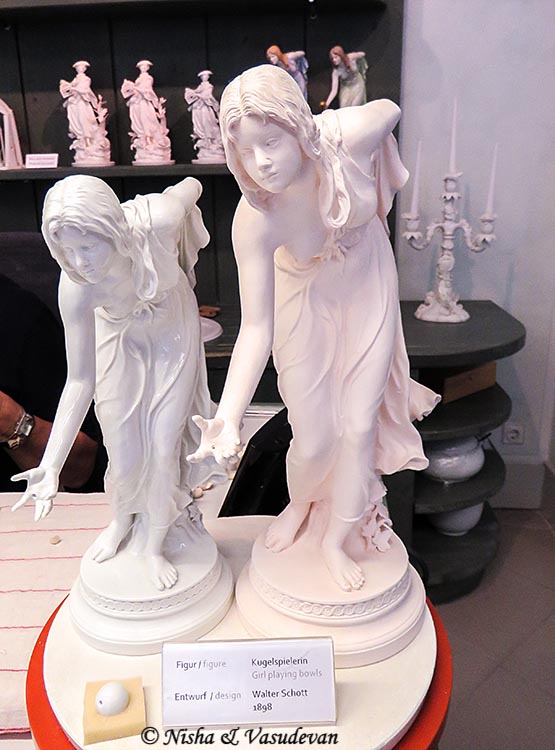
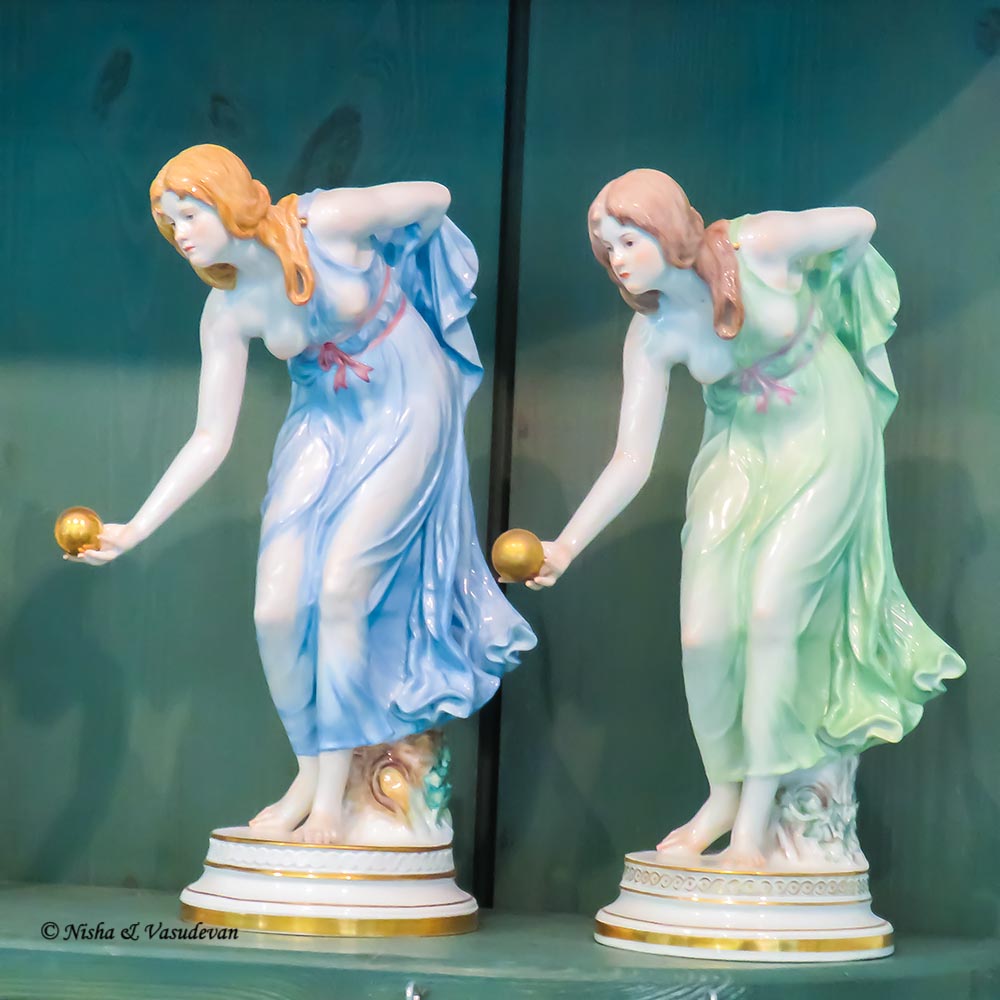
You may also want to read about the Sand Art of Jordan.
We were told that the white clay, called Kaolin, are mined from the company’s own mines. While the artisan was busy putting out the parts to dry; she explained that it was the Kaolin which gives the final product, translucency and other ingredients are for fluxing, color, hardness and strength.
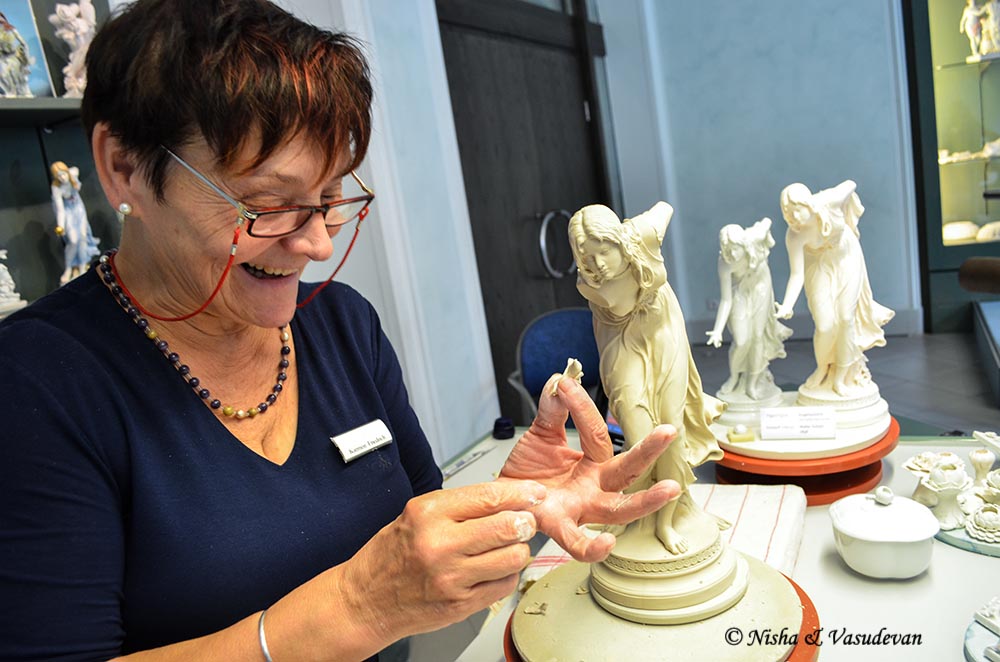
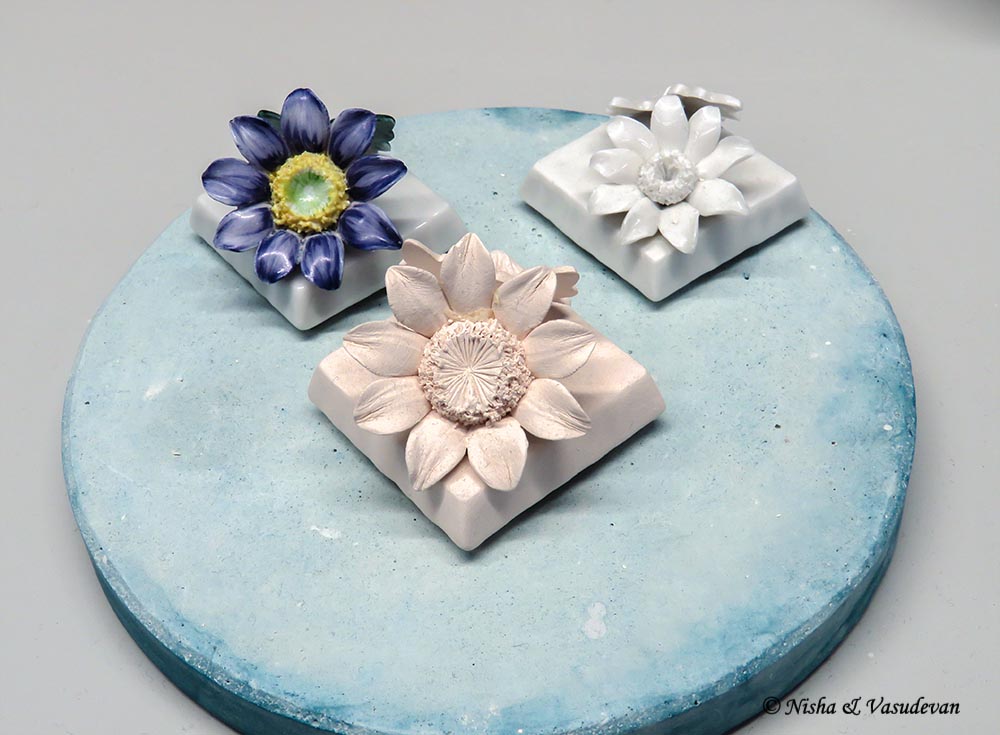
Around this time multiple pieces are joined together to make a whole figurine, if required. Once it is dry the pieces are smoothed and sent out for first firing in the kiln. It is fired for many hours. These pieces are then sent back to another set of artisans for under-glaze painting. A few basic designs may be painted by hand and then sent back to the kiln for glazing and firing again to bond glaze, paint and the base.
After the porcelain objects return from the glazing, more intricate designs are first sketched by pencil upon the surface and later painted using bright colors by the artists. Did I say before it was magic? The steadiness of the hands and the perfection in their skills were mind blowing, to say the least. Finally, the distinctive logo of Meissen Germany, two crossed swords in blue, are painted on reflecting the mark of excellence for over 300 years.
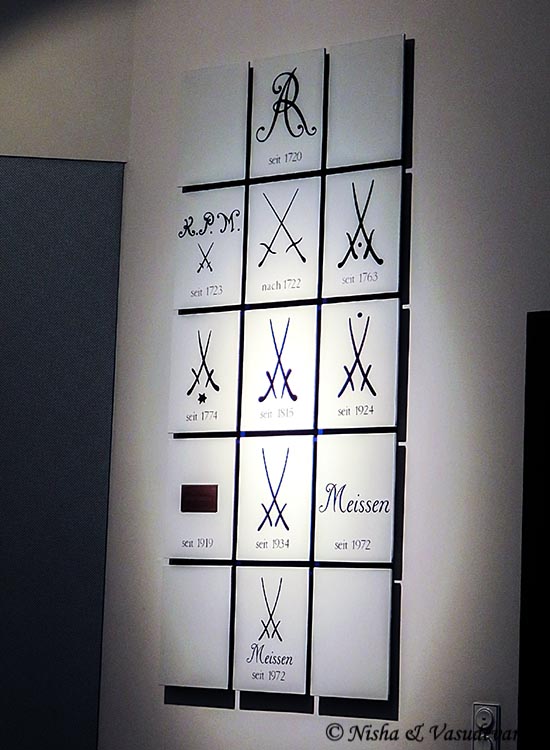
Now the pieces are sent for final round of baking. This time to a temperature that melts the paint particles, softens the glaze there by fusing the paint onto the surface permanently. The paint may often change color during the multiple baking steps. It is the artists who have to use their experience and talent to visualize the final color while mixing the paint.
Whew!
Exhibition of Artifacts
Castle and Cathedral
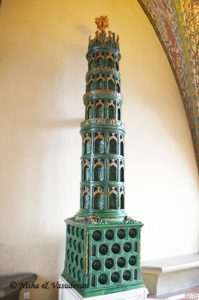
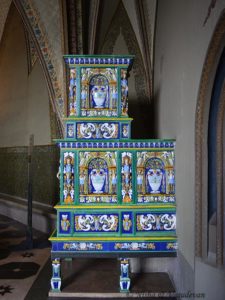
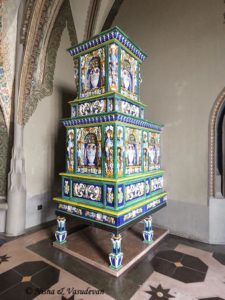
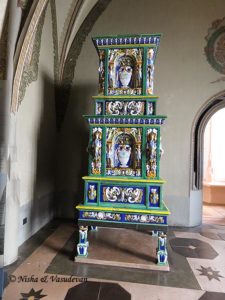
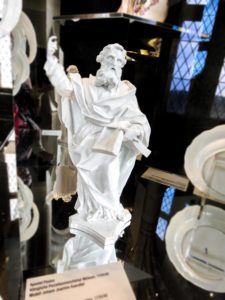
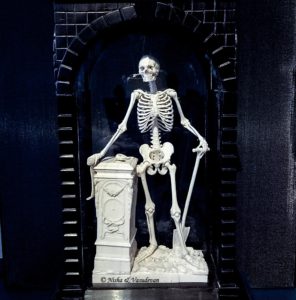
House of Meissen Museum, Dresden
The museum transports us right through the 300 years of Meissen porcelain’s existence in a few minutes. From chamber pot to show pieces of varying sizes, from smallest possible to life-size Saxonia are all being created here? From dinner service to figurines to even radiators we saw a whole gamut of things that are churned out by a few hundred artisans and artists. All handmade.
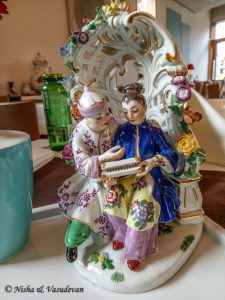

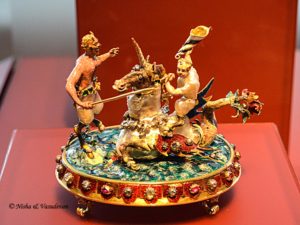
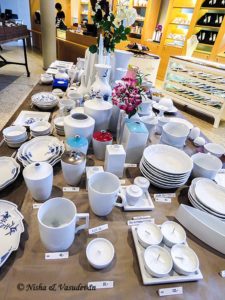
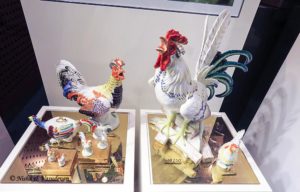
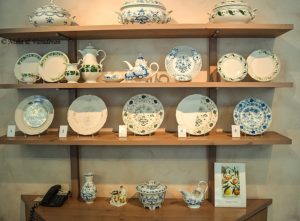
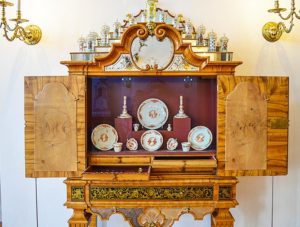
We were later told that the bells of Meissen Cathedral were also made of Meissen Porcelain! We were open-jawed. A porcelain bell? How strong must it be? We always thought porcelain always broke when hit hard……no?
Some of the pieces were so beautiful and intricate that we were sure that, weight for weight, they would definitely be worth more than gold!
Procession of Princes, Dresden
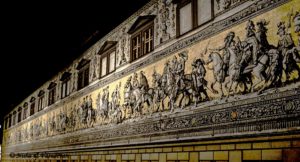
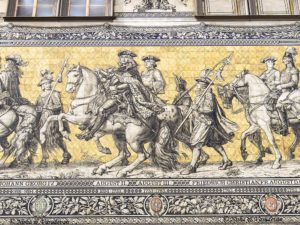
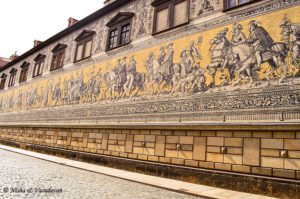
How to reach:
By car – Take B6 main road
By public transport – Train from Dresden to Meissen and then city bus “C” to Porzellan Manufaktur stop.
Tip: If you happen to be in Saxony during Christmas, don’t miss the Christmas Market in the House of Meissen. And guess what… the entrance is free! 😀
Useful Information about (Meißen) Meissen Porcelain Factory and Museum
Opening Hours
Monday to Sunday.
Summer Timings – 1 May to 31 Oct – 9 AM to 6 PM,
Winter Timings – 1 Nov to 30 Apr 9 AM to 5 PM
Ticket Price for Meissen Museum
Adults Eur 10,
Children and concessions – Eur 6,
Family (2 adults + 2 children) – Eur 23.
There are other ticket options when you combine this with Albrechtsburg.
Pro Tip: If you happen to be in Saxony during Christmas, don’t miss the Christmas Market in the House of Meissen. And guess what… the entrance is free! 😀
How to Reach Meissen Porcelain Museum and Factory
By car – Take B6 main road
By public transport – Train from Dresden to Meissen and then city bus “C” to Porzellan Manufaktur stop.
Where to stay in or near Meissen, Germany?
Since Dresden is just about 30 minutes from Meissen, it is best to stay in Dresden as you will find more options for all budgets and do the excursions to various places from Dresden.
Please Click here for accommodation options in Dresden, Germany
Tips, Tidbits and Snippets about Meissen and Meissen Porcelain
- Meissen Porcelain History: Meissen Porcelain is a renowned type of European porcelain produced by the Meissen factory in Germany. It was part of East Germany before German Unification. It is just 30Km from Dresden.
- Augustus the Strong: Meissen Porcelain was first developed in 1708 under the patronage of Augustus the Strong, Elector of Saxony and King of Poland.
- Iconic Blue Onion Pattern: The Blue Onion pattern is one of Meissen’s most famous designs, featuring an intricate combination of blue floral motifs.
- Handcrafted Excellence: Each piece of Meissen Porcelain is meticulously handcrafted, showcasing the skill and craftsmanship of artisans.
- Porcelain Pioneers: The Meissen factory was the first European porcelain manufacturer, setting the stage for the industry’s growth.
- Crossed Swords Mark: Authentic Meissen Porcelain is marked with the famous crossed swords symbol, indicating its origin and quality. Earliest Meissen Porcelain Identification was AR to indicate the king, Augustus Rex.
- White Gold: Porcelain is often referred to as “white gold” due to its historical value and luxurious nature.
- Meissen Collectibles: Meissen Porcelain has become highly collectible over the centuries, with antique pieces fetching high prices at auctions.
- Influential Designs: Meissen’s porcelain designs have influenced other European porcelain manufacturers, leaving a lasting impact on the industry.
- Meissen in Museums: Many museums around the world showcase Meissen Porcelain, celebrating its artistic and historical significance.
- Royal Commemorations: Meissen Porcelain was often commissioned for special occasions and royal commemorations, making it a symbol of prestige.
- Fine Tableware: Meissen Porcelain is favored for elegant table settings, adding a touch of sophistication to any dining experience.
- Restoration and Preservation: Expert restorers work tirelessly to preserve and repair valuable Meissen Porcelain pieces, ensuring their longevity.
- Meissen Today: The Meissen company continues to produce porcelain of the highest quality, blending traditional craftsmanship with contemporary designs.
- Global Appreciation: Meissen Porcelain has a global following, with collectors and enthusiasts appreciating its historical and artistic value.
FAQ Frequently Asked Questions about Meissen Porcelain
Where is Meissen Porcelain Made?
Meissen Porcelain is crafted in the heart of Germany at Meissen Manufactory Porcelain (Porzellan-Manufaktur MEISSEN), where artistic mastery meets timeless elegance. Unleash your passion for perfection with the finest porcelain, born from centuries of tradition and innovation. Welcome to the epitome of sophistication. Meissen: Where Artistry Takes Form.
Can I order Meissen Porcelain online?
Yes, of course. Click here Meissen Online Shop
Is Meissen porcelain valuable?
Yes, Meissen porcelain is highly valuable due to its exceptional craftsmanship, historical significance, and limited production. Collectors and enthusiasts highly covet these exquisite pieces, making them sought-after and valuable in the market. No wonder it is called the “White Gold”
Is Meissen porcelain still made?
Yes, Meissen porcelain is still made today, maintaining its centuries-old tradition of excellence and craftsmanship. With a rich heritage and continued demand from collectors and connoisseurs worldwide, the production of Meissen porcelain remains vibrant and thriving.
Who owns Meissen porcelain?
Meissen porcelain is owned by the State of Saxony, Germany, through the Staatliche Porzellan-Manufaktur Meissen GmbH, ensuring its rich legacy and artistic heritage are protected and preserved for future generations.
What is Meissen Porcelain, and what sets it apart from other ceramics?
Meissen Porcelain is a type of fine porcelain that originated in the town of Meissen, Germany, in the early 18th century. It is renowned for being the first European hard-paste porcelain and is highly valued for its exquisite craftsmanship, translucent appearance, and detailed hand-painted decorations. Unlike soft-paste porcelain, Meissen Porcelain is fired at extremely high temperatures, making it more durable and capable of withstanding everyday use.
Are all Meissen Porcelain pieces hand-painted, and who were the artists responsible for their designs?
Yes, traditional Meissen Porcelain pieces are renowned for their hand-painted decorations. The factory employed skilled artists, including Johann Gregorius Höroldt and Johann Joachim Kaendler, who played a significant role in creating the iconic Meissen designs. Höroldt, in particular, was known for his brilliant use of cobalt blue underglaze decoration, while Kaendler was celebrated for his exquisite figurines and animal sculptures.
What are some of the most sought-after Meissen Porcelain designs or patterns among collectors?
Meissen Porcelain has a rich history of producing various sought-after designs and patterns. Some highly prized ones include the “Blue Onion” pattern, featuring a distinctive blue and white onion motif, the “Indian Flowers” pattern with a vivid mix of colorful floral arrangements, and the “Böttger Steinzeug” or red stoneware pieces, representing some of the earliest Meissen experiments in porcelain production. Additionally, Meissen figurines depicting allegorical or mythological scenes are also highly coveted among collectors.
How did the production of Meissen Porcelain influence the development of European ceramics?
The establishment of the Meissen Porcelain factory in 1710 had a profound impact on European ceramics. Prior to its founding, Europe relied on imported Chinese and Japanese porcelain, but the secret of hard-paste porcelain was not known outside of Asia. Meissen’s success in producing high-quality porcelain led to a surge in interest in porcelain manufacturing across Europe, inspiring other porcelain factories in countries like France, England, and Italy to emerge. Meissen’s techniques and designs became influential and served as a foundation for the development of fine porcelain traditions throughout Europe.
Have you been to Meissen Porcelain Museum? Or any other similar Museum? What was your experience?
You like it? You Pin it!
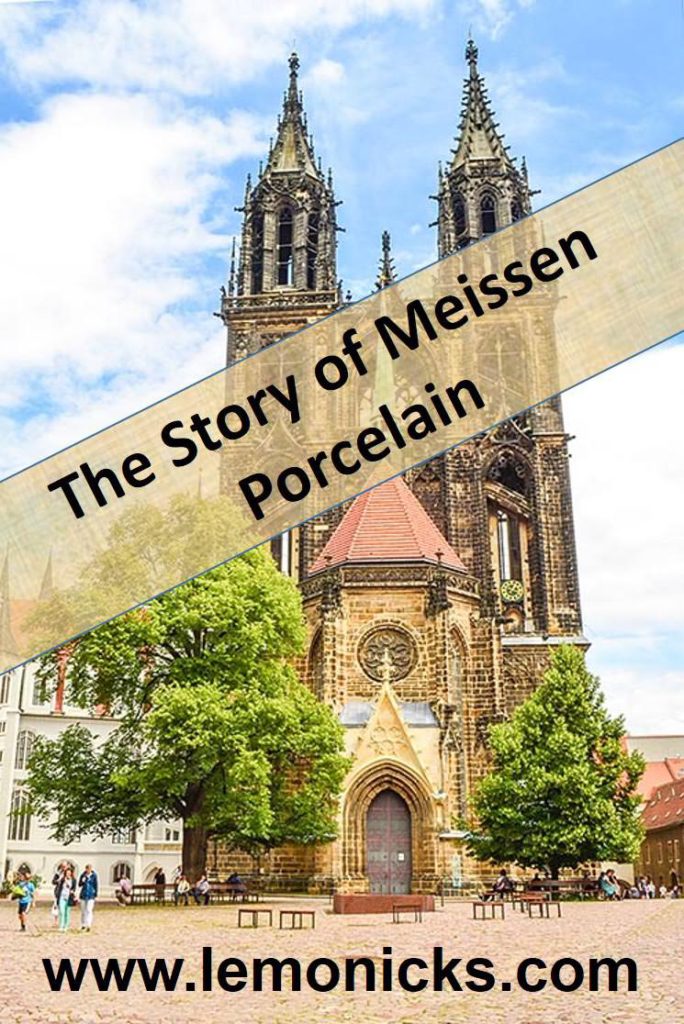
Photograph Copyright
If you want to travel places with us, we invite you to join us on our feed or Facebook Travel page.
P.S.- This article, Story of Meissen White Gold, belongs to Le Monde a Poetic Travail, an Indian Travel Blog, published by the traveling couple, Nisha & Vasudevan. Reproduction without explicit permission is prohibited. If you are viewing this on another website rather than the RSS feed reader or www.lemonicks.com itself, then that website is guilty of stealing our content. Kindly do us a favour by letting us know via Contact Us. Thank you.
All photographs used in this article belong to the owners of this website www.lemonicks.com unless otherwise specified. Copying or using them without explicit permission is prohibited and will amount to copyright infringement.
If you want to travel places with us, we invite you to join our feed or Facebook travel page.
#lemonicks_de01
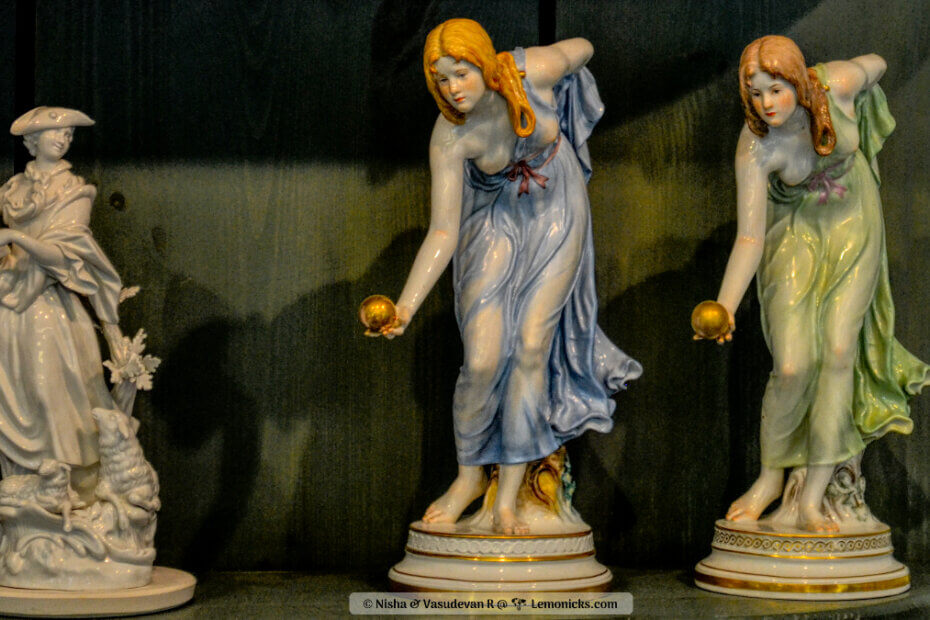

Aha! What an amazing museum and piece of art!
You know I love museums and this one looks perfect for my taste. Do they have a workshop also where we can try our hands?
Yes, Thanks for stopping by. They do have demo workshops but I am not sure if hands-on experience is possible here.
I love the finish of Porcelain, and was always curious about its origination…this beautiful story answers all my questions 🙂 what a wonderful read, thanks, for sharing..cheers!
Thanks. Glad that you liked this post. Hope to bring more such stories.
Very interesting. First time came to know that, sometime porcelain had same value as Gold, white gold :).
The museum is magnificent!
Thanks. Value has always been directly proportional to rarity.
It’s so interesting that porcelain was just as valuable as gold. I never would’ve guessed that. The museum seems to have a lot of great pieces. The Saxonia statue is absolutely stunning! I love all the detail – 8000 handmade flowers!
Like any new “technology” , it had its value. Some of the artisans we met have been at it for decades. Speaks volumes of their intent to keep this heritage alive.
This is so interesting. I didn’t know porcelain was as valuable as gold. I love porcelain, it is very beautiful. I havent been to this museum yet but would love to go. So good you included the opening hours and how to get there 🙂
Thanks Vibeke. Good luck for your travels.
Wow, what an interesting history of porcelain! I had no idea it was so valuable! Also, so many beautiful pieces of art in the museum!
I guess in those days any new invention or discovery was very valuable. This was no less than a magic , that a lump of clay can be transformed into exquisite figurines.
I did not know the history of porcelain, which I’m so glad you gave a brief history of it before diving into the museum. Having that knowledge really made me appreciate and understand the value of porcelain.
Thanks Candy. I am glad you like the article.
This is the first time I read a story on porcelain and its origins. It is truly ‘abracadabra’. These artists are no less than magicians!
Thanks Tania. The artisans and artists are truly gifted.
I will look at porcelain differently now. Thanks for the information.
Ha Ha… collector items, some of them are. 🙂
That Porcelain statue with the amazing floral dress… Is mind blowing. Loved reading the story of how the White Gold was created. Fascinating indeed. Enjoyed seeing the pictures on how and what goes into making these delicate art.
Ami, Thanks. Good to know you liked the piece. The statue was quite incredible and I must admit the photo does not do full justice.
What a fascinating bit of history. The porcelain looks exquisite and created with such craftsmanship. I would love to visit the museum to find out more secrets of these alchemists.
Yes and the main thing is that they have taken care of their heritage. I am sure you will enjoy the House of Meissen.
What a beautiful fairytale-isque castle! Sigh…..
Yes, I agree 🙂 The porcelain is even more fantastic!
I really enjoyed reading your article because I have a deep love for history (blame my mom, she’s a history teacher!) and your storytelling was very compelling. We also have stories and legends about alchemists trying to produce gold in Naples, they are fascinating!
Thanks Dany. Good to know you liked this article. Are there any museums in Naples , relating to Alchemists?
Wow, the view of Meissen cathedral and castle on that hilltop is just stunning, so picturesque! Love the story of Augustus II commissioning an alchemist to make him some gold, and how it resulted instead in the creation of porcelain instead! I had no idea that this was the history of how porcelain was invented, nor how Meissen was it’s epicentre. As budding potters, I think we must make plans to visit the museum and see the techniques and exhibitions for ourselves.
Thanks Kavita, It is indeed incredible that the company still exists after so many centuries. I am sure that the alchemists were at their wits end trying to create the yellow gold and eventually produced something as beautiful.
Wow! What beautiful pieces of art! The amount of delicate detail the artists put into those pieces is incredible.
Absolutely! The artisans we spoke to were quite experienced and dedicated.
oh my grandmother had a few of those plates, i am not just sure if they were of the same quality. they’ve been broken but they were still displayed neatly in open cabinet. as a kid i always wondered why do my old folks keep some broken dining utensils haha. now i understand perfectly why.
Lovely! I am sure it must have been a good quality china. I am not sure now if it has anything more than a sentimental value unless it is realy old and has an antique value
It was fascinating to hear the history of Meissen porcelain. How amazing that the cathedral bells are made from porcelain! The craftsmanship is very impressive, nice to see how people decorate it.
Thanks Susan. We were astounded when we heard about cathedral bells. Unfortunately we could not see it 🙁
Wow amusing the white murals are so gorgeous while the porcelain plates have a great finish. Perosnally I would like to visit this meissein cathedral.
Thanks Judy. There is a lot of things to see at the cathedral too.
8000 handmade flowers on her dress!! They look so pretty! I never knew porcelain was called white gold. It is indeed a very interesting fable! You covered a wonderful story by showcasing those creative artists and their art by visiting the studios! So fine and classy! The artefacts in the museum look fabulous.
Even I thought porcelain was fragile!
A unique article indeed. Why was Augustus 2’s horse on two legs?
Thanks Divyakshi. That statue has become iconic! We would loved to spend hours in the museum but it was closing time too soon. There is a convention that symbolizes hoof position of the horse in a statue or painting. If the horse is rearing on two legs, it means that the rider died in the battle field. However I am not sure if Augustus 2 the strong actually died fighting. So why? I don’t know. Hope one of the reader’s maybe able to answer.
This is my first time to hear about the Meissen Porcelain Museum. It’s interesting to learn about how an organization/ place has come to be. Love how you have included it on your post. I find the museum very interesting to visit. The details of every piece is spectacular! Love how they let guests see how they create their masterpiece…
We had heard of it but never imagined that we would one day get to the land that produces it.
It is truly an amazing experience to watch the artisan’s at work.
Wow! The porcelain is in really good condition. I am so glad the locals take care of it, I been round other parts of Europe where it has been cared for. 🙁 I have to admit, despite all my travels in Germany, this is the first time I have heard of Meissen and I know want to check it out. Fantastic read and good in depth information here.
Thanks Danik, It is indeed marvelous to learn that the factory is still in operation, isn’t it?
Those sculptures of Saxonia are so beautifully made. I want to go to Dresden someday.
Thanks Kristie. I am sure you will not be disappointed. Good luck!
WOW! What a museum!! What beautiful creations, some with such intricacies!!! Great tour and story Nisha. Must have been a treat!
Thanks for stopping by , Deepa. It surely made our day and I think yo must visit it one day.
Wow! The Meissen Porcelain Museum and workshop sound like an amazing stop to view their intricate creations! What a treasure that you were able to behold. I too am amazed that the bells of the Meissen Cathedral were crafted from porcelain – seems impossible! Thank you for sharing information about your tour!
Thanks Val. It is amazing that bells are made of porcelain. Unfortunately we could not see it ourselves 🙁 One can spend hours in the museum if one is a lover.
Wouldn’t it be amazing if you could convert base metals into gold! Interesting that porcelain was worth just as much as gold in those days. It really is such a beautiful material.
The statues in the Meissen Porcelain Museum are quite incredible – Absolutely astonishing to look at the dress of Saxonia and know that it was all handmade! What an opportunity to too get an insight into how it’s all made – I’m with you on the porcelain bell though – I’m amazed that it doesn’t shatter!
History is full of stories of alchemists and wizards trying to create gold out of base metal. Many times they were probably confined and maybe put to a horrible death if they did not succeed, which they did not anyway.
The more I hear about the bells being discussed by the readers ,more I rue the fact that we did not see it 🙁
This is so interesting, I would love to visit this museum for myself. I had no idea that porcelain was this intricate to work with, the process seems fascinating and you’d need a steady hand. I can’t believe porcelain was worth more than gold back in the old days. What a funny world we live in!
Thanks Samantha. Seeing is believing. In fact I must admit that the photos don’t do justice to those pieces of art. I am sure if some one possesses a 300 years Meissen porcelain, it would be worth more than gold because of the antique factor 🙂 🙂
I never knew much about porcelain so this was a great read. I’d love to visit the museum if I ever get the chance! Dresden becomes more and more popular to visit from The Netherlands so who knows for a day 🙂
I am sure you will not be disappointed . Dresden is only a night away by train 🙂 or just about an hour by flight 🙂 🙂
Wow so much story behind porcelain works! Intricate and beautiful they are definitely as precious as gold! Interesting to see the pictures describing the work that has gone into making of it.
Hi Indrani. Thanks . We only wished we had more time at the museum. Maybe another time.
Hii Nisha Mam,
I love to read about a place and its history. Story of White Gold is intriguing and a new thing for me. Its extra ordinary to that Meissen Factory is functional since 300 years. I am sure it must be an awesome experience to be welcome by Saxonia, wow what a sculpture. Loved reading entire process of figurine making.
A true living heritage!
Hi Himanshu. The place does impact you in a certain way. Hope you visit Saxony one of these days. 🙂 Good Luck!
I loved the photo galleries of the porcelain and especially the detailed background. Very interesting to learn its worth in comparison to gold 😉
Thanks Alli. Good to know that you liked it. 🙂 I guess the value was because of the rarity . Hope you make it to Saxony one day.
I’m going to Germany for Christmas but unfortunately not to Dresden! The museum does seem really unique and interesting. The artifacts are really elaborate but what I would like the most is watching the artisans using the clay in order to make them. I wish there was a lesson there for that!
I am told Dresden is great during Christmas too. Dunno where you will be in Germany but Dresden could not be more than 3-4 hours 🙂
Very cool. It’s always great to read the history behind things you know (I’m familiar with Meissen porcelain but never knew the story). Porcelain bells, who knew?!
Thanks Peter. Absolutely! When one hears the story and see the artisans and their creations, one can only be open-jawed at the marvel.
What a fantastic blog post! I knew nothing about the process of creating porcelain, although I have long admired porcelain pieces, especially Lladro figurines. The skill with which Meissen artists paint the details is incredible! This also reminds me of the time we visited the workshop of a three-generation santon creator, but santons (clay nativity figures hand-carved in France) are much more rudimentary than these beautiful porcelain pieces.
Thanks Tami. The artists and artisans have ensured that they will keep alive the tradition of Meissen Porcelain. I have heard of Santons but have not been there. Maybe time will come!
Wow hand painting those pieces is incredible. I have no idea how anyone keeps their hands steady enough to do it. I tried to paint a pot once and that was shocking enough.
Thanks Anne. I agree. The artisans we met had been at it for decades! I would not even want to try unless I was making a slap-stick video 🙂 🙂
Wow, I never knew about the value of porcelain, how interesting! I take my hat off to the hand painters. It’s an art form that requires a lot of precision!
OMG! That is just so beautiful. I am actually short of words to praise it. That Saxona Statue of Liberty is just mind-blowing. Hats off to these artists. Your posts and pictures have captured House of Meissen really well.
Thank you for taking me back on a nostalgic trip down the memory lane. What I remember most from my Meissen Porcelain visit is their demo – how they show it step by step the process of hand painting and creating these beautiful pieces. I think I still have their jewelry catalog with me.